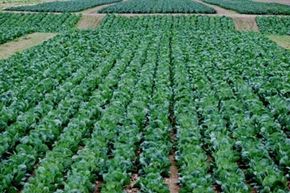Main Components of Sustainable Agriculture
The main components of both sustainable farming and conventional farming are exactly the same: soil management, crop management, water management, disease/pest management and waste management. It's the methods used that are often radically different. We'll discuss them in order, starting with soil management.
On a conventional farm, managing and maintaining soil fertility is as simple as running a soil test and applying the recommended doses of nitrogen, phosphorus, potassium and other nutrients to meet crop needs. In sustainable agriculture, soil fertility is maintained and improved through a careful rotation of crops and generous amounts of compost and green manure, which are cover crops that are plowed back into the soil to enrich organic matter.
Advertisement
Monoculture is the term for agriculture that only produces one crop, year after year. The danger of monoculture is that it requires more and more chemical fertilizer to replenish lost nutrients, and more and stronger chemical pesticides and fungicides to kill off the bugs and diseases that evolve alongside the same crop year after year. Sustainable agriculture employs a broad crop diversity and careful rotation, so that nutrients are replenished naturally and no single pest or disease is allowed to get out of control.
Unhealthy soils are easily eroded, and careless water management can allow chemical fertilizers, pesticides and fresh manure slurry to leach into rivers, streams and the drinking water supply [source: Sustainable Agriculture Initiative]. Sustainable water management views water as a precious resource, efficiently watering crops using drip irrigation, which cuts down on erosion and evaporation. Efficient water use is hugely important in arid climates, where sustainable farmers plant drought-resistant crops and limit animal grazing [source: Feenstra].
On a factory farm, the key to fighting infections and disease among confined animals is to treat them with prophylactic antibiotics. Conventional growers rid the soil of any potentially harmful diseases by spraying it with fungicides before planting, then bathing the growing plants in strong pesticides to kill off bugs. In sustainable farming, plants and animals are encouraged to use their natural resistance rather than chemical solutions. Animals that freely graze on a healthy diet are more resistant to infection and disease. Healthy plants grown in microbe- and nutrient-rich soil are more resistant to invading bugs and disease. When necessary, sustainable farmers will use natural solutions to pest and disease problems, including row covers and sprays made from natural ingredients.
Dairy farms, in particular, create an impressive amount of manure. In a sustainable waste management plan, the manure would be properly composted (which requires sufficient internal heat and turning of the compost piles) and applied to field or food crops. One promising new technology called an anaerobic digestor can convert animal waste into methane, which can provide a renewable on-farm source of electricity [source: SARE].
For lots more information on sustainable gardening and organic food, head to the links on the next page.
